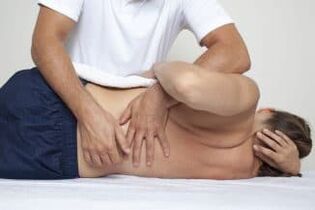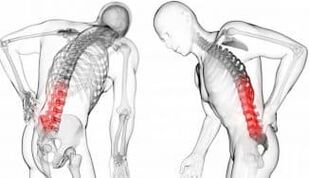Osteochondrosis is a cartilage dystrophic change that occurs due to aging processes and negative external exposure.Most often, it appears in the intervertebral discs, so the most common types of osteochondrosis are lumbar, cervical and chest.Osteochondrosis of the lumbar region causes spine pain and spine appearance, so you should start high quality and qualified treatment as soon as possible.In the article, we will discuss the main symptoms and methods of treatment of lumbar osteochondrosis.
Diseases of the disease
Osteochondrosis of the lumbar region is characterized by dystrophic changes of intervertebral discs(Rash, deformation, loss of elasticity).As a result, the pain occurs, action and mobility are lost.No person is protected from the disease.The human spine is constantly undergoing vertical load.Negative factors (sedentary lifestyle, excessive physical activity) only exacerbates the situation.After 30-35, a certain percentage of people begins the experience of discomfort in the lumbar region.
Causes of Development
There are many factors that can lead to osteochondrosis.Most often, the disease occurs due to the predisposition of the spine and uneven load.In addition, the causes of dystrophic change of cartilage are: become:
- A tempting lifestyle;
- AttendScoliosis;
- A weak tone of muscles;
- ConstantSharp;
- Lack of micro and macroelemies in nutrition;
- ProfessionalExcellent sport.
The existence of the above factors significantly increases the likelihood of osteochondrosis in a relatively young age.
Symptoms
The main symptom of the disease is pain in the lumbar region.The following manifestations arise at the stage of injury:
- The first stage-The complete absence of any sign, fatigue may occur;
- The second stage- Periodic pain in the lower back;
- The third stage- Permanent pain, curve and appearance;
- Phase of the fourth stage- Expressed pain syndrome for any movement, for the movement of the spine.
Osteochondrosis is quite easy to determine with the main symptom.If a person occurs periodically with pain in the lower part, you should visit your doctor.
In the fourth stage of the disease, one can completely lose work capabilities and become a person with disabilities.
Diagnostics
Techniques and diagnostic tests are used to identify the disease.First, the doctor conducts visual examination and testing.It is important to exclude diseases with similar symptoms.Used to determine the degree of harm:
- MRI;
- X -Ray;
- Ct.
After checking and conducting various tests, a preliminary diagnosis is made.Using the technique examination, it is possible to accurately determine the cause of weakness.Osteochondrosis at the first stage can only be detected using computing or magnetic -resonance imaging.
Reflex Lakega
Lacega reflex is a symptom that is detected only by neurological and dystrophic spine pathologies.The presence of a reflex of lags is determined by a neuropathologist.This is as follows: a person takes a lie position;The doctor corrects the straight leg.If the person has more than 30 degrees Celsius, the pain occurs, then the test is considered positive.For the test, special devices are not required, so it is performed even during the initial examination.
Take the test correctly to determine Lazaga's symptom only with your doctor.Using this test, you can almost accurately determine the area of damage.
Knee reflex
This pattern is almost always carried out on the basis of an initial check.The essence of the reflex is that if you press the knees on a flat surface, it has pain syndrome.It should be noted that this test is not always positive with dystrophic changes in the intervertebral discs, but it does not take much time to spend.With a positive result, your doctor may make a preliminary diagnosis of osteochondrosis.
Technique Methods
Technique studies are most effective in diagnosing osteochondrosis.A computer or magnetic resonance imaging is used.X -ray examination of the lumbar region will also help you make a diagnosis.These methods allow to evaluate the degree of damage and the distance between the vertebrates.In addition, with their help, complications can be diagnosed, which often occurs during illness (hernia, curve).
Treat
Treatment of osteochondrosis should be difficult.When therapy, you need to follow the following principles:
- Exclusion of provoking factors;
- Elimination of related pathologies;
- Removal of inflammation;
- Stimulating cartilage recovery.
The success of treatment depends not only on the doctor but also on the person.It will be necessary to observe the regimen, involve physiotherapy exercises, go to physiotherapy.Some medication is used only during the acute period.
Throughout therapy, it is necessary to exclude vertical loads on the spine, as this can be exacerbated by the pathology.
Remedy
Medications are used during the acute period of the course of the disease.The main task is to get rid of pain and inflammation.This can be used as drugs, injections and tablets.The following classes of drugs are used:
- Analgesics;
- Non -anti -anti -Anamals;
- Chondroprotectors;
- Muscle calmers;
- Vasodilators.
Specific drugs choose a doctor.Injection of NSAIDs to the affected side will help to relieve the pain quickly.Chondroprotectors will help to stop dystrophic changes and begin the recovery process.With the help of medication, you can effectively fight only the first and second stages of osteochondrosis, more complex treatment methods are used for more difficult cases.
Physiotherapeutic procedures
Physiotherapy helps to get rid of minor pains and consolidate the outcome of drug treatment.The following procedures are used:
- Phonophoresis;
- Magnetotherapy;
- Impact of vibration;
- Dutoenzor-therapy.
Most procedures can only be performed during remission.The moment of use of physiotherapy is most appropriate by your doctor.To achieve a therapeutic effect, you should regularly visit the physiotherapy cabinet.At least 7-10 procedures are needed to achieve constant improvement.
Manual therapy

With the help of manual therapy, it is possible to get rid of gravity, muscle spasms and pain.Direct impact on the affected area with your hands allows you to create conditions for the speed of the spine.With osteochondrosis, it is possible to remove the load that can occur due to inappropriate posture.The manual specialist acts on the waist and the entire back massage movements.The effect of manual therapy is noticeable after several procedures.
Manual therapy should only be performed by a qualified specialist who has all the necessary certificates.The improper effect of the spine exacerbates the situation.
Medical physical education
A person with osteochondrosis should try to correct posture and strengthen the muscle corset.The LFK complex can be used during remission.The following exercises can be performed:
- Knee and focus.Perform yourself and turn the lower back, then rinse your head, return to your original position.Repeat 8-10 times.
- Stand on your back.Alternally, slide your feet into the knee joint.Repeat 10-12 times.
When muscles are strengthened, the load can be increased.Static exercises can be used to strengthen lumbar muscles.A specific complex is selected based on the individual characteristics of the person and the degree of damage to osteochondrosis.After the constant remission is achieved, you must continue to get involved in physical education.This is one of the best prevention of the disease.
Folk recipes
Various natural compresses can be used to relieve pain and inflammation.Highlighted among the most effective recipes:
- Compress from mustard and vodka.It will require 50 g of dry mustard, 100 ml of vodka and 50 ml of camera alcohol.The components were mixed and insisted on 10 hours.The gearbox is moisturizing the resulting liquid and applies to the affected side for 20-25 minutes 2 times a day.The course of treatment is 7-10 days.
- Compression of crude potatoes and honey.Clean and grate the potatoes, then mix it with honey.Place the resulting consistency in the lumbar region, cover with polyethylene and fix it.Compression is kept for 30-45 minutes.
Heating compresses will help to get rid of the pain.Constant improvement can be improved when merging with other methods of treatment.
Surgical intervention
Surgical intervention is an extreme size used in the case of irreversible changes in tissues.Using surgery, the cause of the pain is eliminated.Most often, discochatomy is performed, in which the intervertebral disc of nerve compression is partially or completely eliminated.A particular type of surgical intervention is individually selected.It should be noted that it is quite difficult to perform spine surgery.
The therapeutic effect of one surgical intervention has not always been achieved.If a person has been withdrawn for a long time with treatment, several surgeries may be needed.
Prevention
People can easily interfere with or stop the development of osteochondrosis using prevention.The following actions will be required:
- ApplyOrthopedic mattresses and pillows;
- Follow the posture, Especially seductive lifestyle;
- ApplyExercise therapy;
- Swimming;
- Balanced eating;
- Visit a massage.
You will also need to regularly undergo preventive examinations using modern equipment methods.And with osteochondrosis, it is advisable not to get involved in heavy sports.This applies to the lumbar spine not only the prevention of osteochondrosis, but also the intervertebral osteochondrosis of the chest.
Possible complications

First of all, osteochondrosis is exacerbated by severe pain.During the development of the disease, the distance between the vertebrates decreases.Finally, it causes a blow to nerve and severe pain syndrome.In addition,The following complications may appear:
- Protrusion;
- Intervertebral hernia;
- Spinal cord blood supply disorder;
- Paralysis.
Earlier, a person begins treatment, unlikely to have any complications of osteochondrosis.The most dangerous is the protrusion of cervical osteochondrosis, but that does not mean that they are less dangerous in the lumbar region.
Findings
- Osteochondrosis is a degenerative disease in which the elasticity and mobility of the spine discs is lost.
- The disease begins due to low activity, severe scoliosis or unbalanced diet.
- With a competent therapeutic approach, you can completely stop the development of dystrophic changes.However, severe forms of the disease are treated through surgical intervention.
- Prevention is required to lead a healthy lifestyle, monitor posture, and avoid heavy loads.
- If you start the course of the disease,There is a risk of serious complications.

























